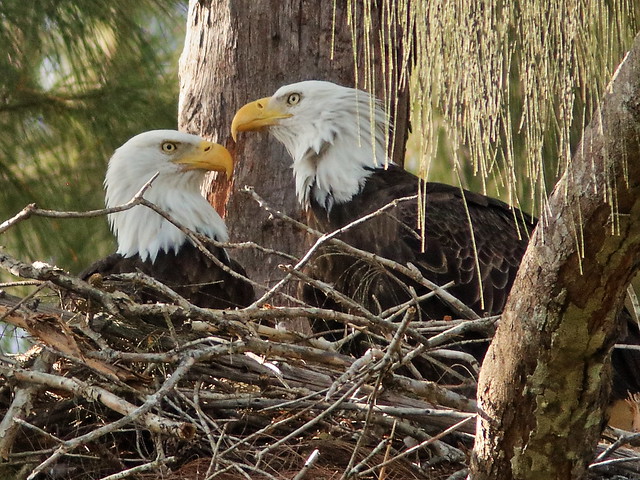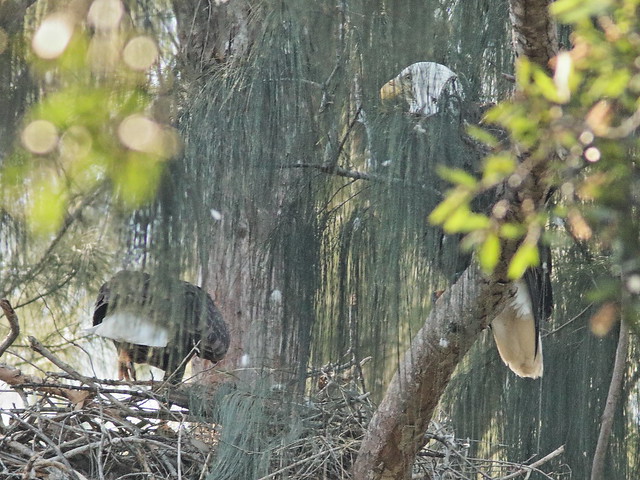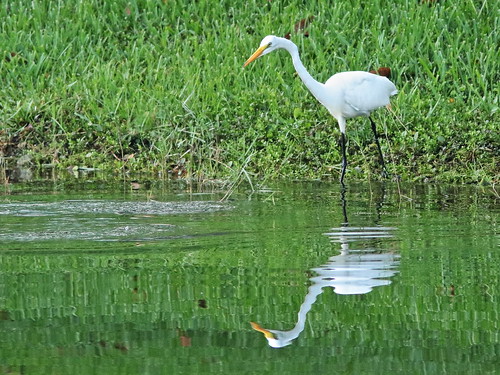

The nest on November 2:

Both members of the pair spent much time on the nest. (November 24). Jewel is on the left:

They copulated, this time on November 26:

Their first clutch was laid in late November and was expected to hatch in early January, 2020.
The pair exchanged incubation duties. Here, the male is waiting to replace Jewel who is about to fly off (December 7):

Jewel departs and turns over incubation duties:

There was visual and photographic evidence of at least one eaglet being fed in the nest just before a storm on January 4. The storm was fierce and caused wind damage and at least one tornado. The next day some observers believed that the adult was feeding one or more eaglets, but there were no confirmed sightings. Another bad storm occurred on January 10.
In between the storms the adults were busy repairing the nest, which lost a considerable amount of its bulk, especially on the right (west) side. We presumed that the eaglet(s) and any unhatched eggs were lost between January 4th & 10th. Pride & Jewel repairing nest (January 11, 2020):

They repaired the nest and were seen copulating in late January. A second clutch of eggs was deposited in mid-February, and there was evidence that the first egg had hatched on or about March 14. Two eaglets hatched, the 24th and 25th eaglets known to have been produced in this nest since South Florida Audubon began monitoring the nest in 2007. The same male (Pride) has been present since then, and Joy was his first mate. She disappeared in October, 2014 and soon was replaced by Jewel, a young (4 year old) female.
Here are both eaglets on April 8, 2020, when they were about 3 1/2 weeks old. The younger male, standing high on the right, still has a tuft of natal down on his head:

This is the first-hatched eaglet (P Piney 24), presumably a female, on April 11. Bald Eagle eggs are deposited every 2-3 days and hatch asynchronously. Two out of every three first-hatched are females:

Female eaglets grow rapidly and are very competitive with nest-mates. If the second-hatched is also female, they will fight for dominance and often the younger bird either starves or may be killed by her sibling. A younger male will usually not challenge an older female, so this is the best combination for survival of both if food is abundant.
Both eaglets were loafing out on the branches on June 26, when they were about 15 weeks (105 days) old. The male, in the foreground has darker feathers than the female:

The darker plumage of the male is an individual variation, not linked to its gender, so far as I can determine:

Note the more massive head of the female. The large bill, more prominent "brow." and the greater extension of the gape (corner of beak) below her eye is characteristic of female Bald Eagles:

As is usually the case, the female was first to fledge, taking her first flight on May 21 at the age of 68 days. She disappeared until May 30. The male fledged on June 3 and returned to the nest the next day. They will come to the nest to be fed by the parents. The adults deposit prey into the nest to attract the eaglets, a practice which most efficiently allows them to feed and protect them in one location. For several weeks they will accompany the adults on foraging trips as they gain hunting skills.
Here is a Link to spreadsheet which tracks events at the nest over the past 11 breeding seasons:
http://www.rosyfinch.com/EagleMilestonesSheet.pdf
Meanwhile, out on the local wetlands, a male Bobcat walked along the edge of the gravel path. He was quite distant and I got poor photos, so I stitched them together into a composite image which shows him progressing along. He looked back at me and then continued on his way:.


Great Egret at the shore of our lake:

Storm trying to beat us to our home:

= = = = = = = = = = = = = = =
Linking to:
Skywatch Friday
Weekend Reflections
Saturday's Critters
BirdD'Pot
Camera Critters
All Seasons
Wordless Wednesday (on Tuesday)
Natasha Musing
Our World Tuesday
________________________________________________
Please visit the links to all these posts to see some excellent photos on display
________________________________________________
eagles are great
ReplyDeleteWhat an amazing report! Wow!
ReplyDeleteWOW! These are fantastic shots. Thank you for sharing.
ReplyDeletehttps://nanchi.blog/
Amazing photos and fascinating detailed information! Loved this post! Your dedication is commendable.
ReplyDeleteHello Ken,
ReplyDeleteAwesome post and photos on the Bald Eagle and the Eaglets. It is wonderful they did so well. I love the Bobcat stitched image, The sky shot is beautiful. Thank you for linking up and sharing your post. Enjoy your day, have a great weekend! PS, thanks for visiting my blog and for the comment.
As much as I love the Eagle photos...I love the Bobcat even more. Neat way that you stitched the photos together! Very creative! Happy weekend! Hope that bad storm veers away from us!
ReplyDeleteSo great that they manages to raise a second brood successfully. Love the Bobcat as well. Keep well and have a good week, Diane
ReplyDeleteWe have a bobcat in a refuge...wish I could get a glimpse of it. Your eagle records and photos...awesome (thanks for linking in at IRBB)
ReplyDeleteGreat reflection! The eagle photos are outstanding!
ReplyDeleteAn incredible series of pictures, all so sharp and clear, accompanied by an informative, well-crafted narrative. It doesn't get much better than this.
ReplyDeletefascinating.
ReplyDeleteI absolutely LOVE the eagle series - super!
ReplyDeleteThank you for sharing at http://image-in-ing.blogspot.com/2020/08/pretty-posies.html
Hi Kenneth aka Rosyfinch from a first-time visitor to your blog who came in from another blog (Stevenson Q). This post of the eagles was so fascinating and information. I knew very little about the nesting of adult eagles, and enjoyed seeing all the photos of Pride and Jewel and the eaglets, which don't look anything like the parents (yet). Also, I read your "About Me" and like yourself, my husband and I are also NJ natives. We now live in New England (Nashua, NH) after a dozen years on the VA Eastern Shore where we saw egrets and herons quite often.
ReplyDeleteWOW, What great pictures! We have eagles that fly around our city. I believe there's only two I was told. There's a law not to hurt them too. God help someone who does. One day I saw our eagle at the very top of the Church steeple just looking around like he was protecting our city & I took a picture. I'm going to have to dig that out & post it one day! Thank you so much for sharing. Your pictures are gorgeous! Bless you & yours!
ReplyDeleteSo much information about the bald eagles and their nesting habits. Its very painful when the nests get destroyed and they lose their eggs or little ones. Pride & Jewel make a handsome pair. It's interesting to know the female is dominating...... :)
ReplyDeleteBeautiful photos and a great report! I’m glad the eagles were finally able to raise their offspring, after all the suffering they went through. Such majestic creatures. Nice series with the Bobcat - and superb sky shot as always. Greetings from Sri Lanka!
ReplyDeleteThanks for letting us know about this lovely pair of beauties!
ReplyDeleteHow terrific it is to see you at 'My Corner of the World' this week!! Thanks for linking up with us.
Your series of the eagles is riveting, Ken! am so happy you keep us at All Seasons up to date with them. Such
ReplyDeletemajestic birds. Hope to see them at some Point:) Thank you for your kind words about the painting of the virgins:) Jesh
Really great photos and interesting information.
ReplyDeleteAs always I'm blown away by all your pictures Ken.
ReplyDeletePride and Jewel are truly precious and thank you for raking usb through their journey.
"Female eaglets grow rapidly and are very competitive with nest-mates. If the second-hatched is also female, they will fight for dominance and often the younger bird either starves or may be killed by her sibling. A younger male will usually not challenge an older female, so this is the best combination for survival of both if food is abundant."
I learned something new. :)
And wow what a Bob cat sighting that!
Are these all in Florida?
Absolutely a pleasure to host you on #WordlessWednesday
Also I sent you a Friend's request on Facebook where I have been sharing yours posts. :)
ReplyDeleteHello my dear friend Kenneth! Thank you so much for this series of beautiful photographs that you shared to us! Those eagles are simple captivating, they look very strong and I am always amazed to see more than one of them together because I see how independent they are with the way they carry themselves.
ReplyDeleteThank you so much for joining this week's and being a frequent of Timeless Thursdays Kenneth! It's always so nice to have you on my humble linky :) Wish you a great rest of the week!